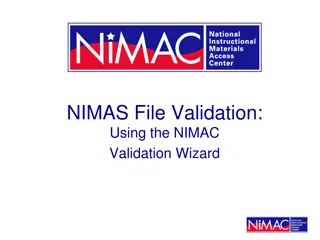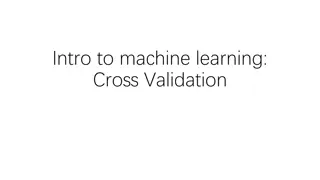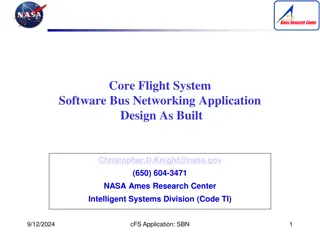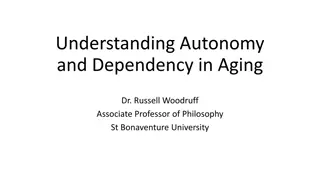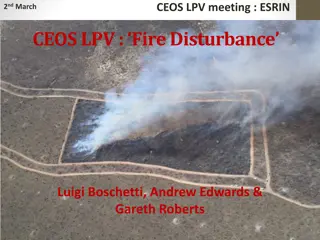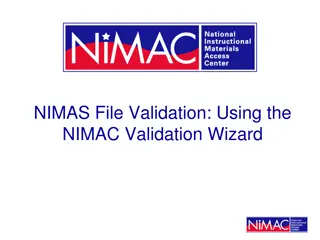Validation of Simulated Environment for CFS Autonomy
This study focuses on validating a simulated environment developed for analyzing Cognitive Function Synthesis (CFS) navigation autonomy. The research aims to identify dependent and independent variables, design experiments, and present findings regarding system performance with and without an Obstacle Avoidance Algorithm.
Download Presentation

Please find below an Image/Link to download the presentation.
The content on the website is provided AS IS for your information and personal use only. It may not be sold, licensed, or shared on other websites without obtaining consent from the author.If you encounter any issues during the download, it is possible that the publisher has removed the file from their server.
You are allowed to download the files provided on this website for personal or commercial use, subject to the condition that they are used lawfully. All files are the property of their respective owners.
The content on the website is provided AS IS for your information and personal use only. It may not be sold, licensed, or shared on other websites without obtaining consent from the author.
E N D
Presentation Transcript
Design and Analysis of Startle test in laboratory rats Kanaka Tatikola & Stan Altan 6/18/2019
Introduction Context : Reproductive toxicology Problem: When a battery of stimulus is applied serially, residual effects exist and they are confounded with treatment effects An innovative solution: incorporate serially balanced designs sequences to separate treatment effects from residual effects
outline Overview of Reproductive toxicology Serially Balanced Designs -General Context and Construction of the Statistical Design A Case study: An innovative design in neuroBehavioral toxicology Summary and Remarks
Overview of Repro tox studies Reproductive toxicology is study of animal for effects of drug during Pre-Mating to conception Conception to implantation Implantation and organ formation Organ formation to end of pregnancy Birth to Weaning Weaning to sexual maturity
Types of Reprotoxic studies Fertility studies Pre-post natal Teratology studies embryo fetal development Juvenile tox studies
focus on behavioral Tox Behavioral development (motor activity, water maze learning and memory, startle responses etc) Regardless of the specific protocol used, proper conduct and statistical analyses of the data are critical.
Startle test Auditory Startle system(SDI) Rats are assigned to chambers and a series of stimuli is applied in a pre-planned fashion Three stimuli: N(No stimulus), A (Auditory), Preplulse(P) Startle response to measures ad latency(VT),Threshold(VAVE) and Amplitude(VMax)
The basic rule for the sequence is as follows : If there are v distinct treatments, the treatments should be arranged in a sequence such that any pair of distinct tretaments occur together equally often. When this is the case, such sequences are known as serially balanced sequences (designs).
Serially balanced designs Serially balanced sequences Type 1 Sequence : Every treatment produces carryover effect on itself and every other treatment an equal number of times Type 2 Sequence : Every treatment produces carryover effect on every other treatment an equal number of times [Finney and Outhwaite (1955, 1956)] The work of Williams (1949) A simple method of construction of type 2 sequences balanced for residual effects of minimal length restriction that every ordered pair of distinct symbols appears once column-wise in consecutive rows. A Latin Square of order v is a square array of dimension v, consisting of v symbols, such that each symbol appears once in each row and column.
Serially Balanced Design for v=6 The Type 2 sequence constructed by this method for v=6 based on the Williams latin square is 0* 1 5 2 4 3 4 2 5 1 0 3 5 4 5 3 0 2 1 2 0 5 0 4 1 3 2 3 1 4 0 *No response 11
Serially Balanced Design for v=6 The Type 1 sequence is obtained by repeating each of the treatments once following itself anywhere in the Type 2 sequence 0* 1 1 5 2 4 3 4 2 2 5 1 0 0 3 5 4 4 5 3 0 2 1 2 0 5 5 0 4 1 3 3 2 3 1 4 0 *No response 12
Case Study A serially balanced Type 2 design combined with other factors is implemented as follows: Drug: known test compound affecting neuro behavioral parameters Drug Levels: l(low), m(medium), high(h) Randomization: 24 animals randomized to 3 level => 2 of six unique test sessions/level => replicate Control & Drug => initial Auditory stimuli followed 37 randomized trials of stimuli Stimulus: o Auditory: a single stimulus of 120 dB o No-stimulus: background noise only o Prepulse: a stimulus of 85 dB followed 50 ms later by a second stimulus of 120 dB Response: o Vmax(mv): the maximal amplitude of response o Vave(mv): voltage changes averaged during the testing window o Tmax(s): time at maximal amplitude
Objectives?? To estimate an unbiased estimate from response to stimuli
Exploratory full model Ylkj(i)m= + Li +Gj (i)+ k(j(i)) + l + (TL)li + (TG)lj(i)+(TG )lkj(i) + VDm + (VDL)mi+(VDG)mj(i) + (VDT)ml+ (VDTL)mli + (VDTG)mlj(i) + VRm + (VRL)mi+(VRG)mj(i) + (VRT)ml+ (VRTL)mli + (VRTG)mlj(i) + lkjim Ylkj(i)m = mth trial of kth animal in jth sequence group, lth treatment in ith drug level : overall mean Li: effect of the ith level of drug Gj(i) : effect of the jth sequence within ith level of drug k(j(i)):Random animal effect, k(ij) ~ N(0, 2 ) Tl: effect of the lth trt (TL)li: interaction of the lth trt and ith level (TG)lj(i): interaction of the lth trt and jth sequence within ith drug level (TG )lk(j(i)): interaction of lth trt and kth animal within ith level and jth sequence (TG ))k(j(i)) ~ N(0, 2TG ) VDm : Direct effect of the mth stimulus (VDL)mi: interaction of the mth stimulus and ith level (VDT)ml interaction of the mth stimulus and lth treatment (VDTL)mli : interaction of the mth stimulus, lth trt, ith level (VDTG)mlj(i) : interaction of the mth stimulus, lth trt and jth sequence within ith level VRm : Residual effect of the m-1th stimulus (VRL)mi: interaction of the mth residual and ith level (VRT)ml interaction of the mth residual and lth treatment (VRTL)mli : interaction of the mth residual, lth trt, ithevel (VRTG)mlj(i) : interaction of the mth residual, lth trt and jth sequence within ith level lkjim : error term
Results : ANOVA and LSMs Type 3 Tests of Fixed Effects Effect level seq(level) trt trt*level seq*trt(level) stim level*stim seq*stim(level) trt*stim trt*level*stim seq*trt*stim(level) resid resid*level seq*resid(level) trt*resid trt*resid*level seq*trt*resid(level) Num DF Den DF F Value 3.47 0.69 2.68 2.18 1.27 2707.39 12.63 10.02 19.55 4.38 3.31 20.39 0.37 1.11 0.74 2.89 0.57 Pr > F 0.053 0.5704 0.119 0.1414 0.3153 <.0001 <.0001 <.0001 <.0001 0.0016 0.003 <.0001 0.8279 0.3512 0.4762 0.0211 0.7568 2 3 1 2 3 2 4 6 2 4 6 2 4 6 2 4 6 18 18 18 18 18 Covariance Parameter Estimates Cov Parm ANO(seq*level) ANO*trt(seq*level) Residual Estimate % Contribution 0.20 0.11 0.87 23% 9% 74% 1632 1632 1632 1632 1632 1632 1632 1632 1632 1632 1632 1632
Reduced final model Ylkj(i)m= + Li + k(j(i)) + (TL)li + (TG)lj(i)+(TG )lk(j(i))+(VDTL)mli + (VRTL)mli + lkjim Ylkj(i)m = mth trial of kth animal in jth sequence group, lth treatment in ith drug level : overall mean Li: effect of the ith level of drug k(j(i)):Random animal effect, k(j(i)) ~ N(0, 2 ) (TL)li: interaction of the lth trt and ith level (TG )lk(j(i)): random interaction effect of lth trt and kth animal within ith level and jth sequence, , TG lk(ij) ~ N(0, 2TG ) (VDTL)mli : interaction of the Direct effect of mth stimulus, lth trt, ith level (VRTL)mli : interaction of the Residual effect of m-1th stimulus, lth trt, ith level lkjim : error term
Reduced model Type 3 Tests of Fixed Effects Effect level trt*level trt*level*stim Num DF Den DF F Value 2 3 12 1656 Pr > F Covariance Parameter Estimates 21 21 3.64 0.0441 2.26 0.1108 436.62 <.0001 Cov Parm ANO(level) ANO*trt(level) Residual Estimate % Contribution 0.18 0.11 0.92 15% 9% 76% 12 1656 4.38 <.0001 trt*resid*level
Interaction plots Interaction plots level*stimulus*trt level*residual*trt
Conclusions Permits unbiased estimate of response to stimuli free of residual effects Trt*level*stimulus interaction which indicated a response profile across drug levels was related to administration of test compound. Residual effects were found to be substantial and also dose and drug level related because of trt*level interaction Use of a serially balanced design is a powerful way of estimating trt effects in the presence of residual effects




